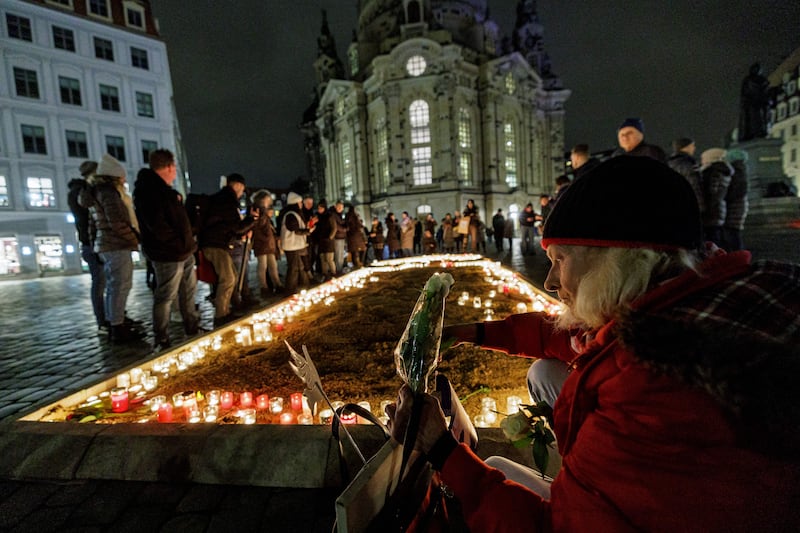The half-ruined altarpiece of Dresden’s Three Kings church, with its gaping cracks and missing pieces, is a mesmerising memorial to the city’s darkest hour: February 13th, 1945.
Exactly 80 years ago, one of Europe’s most beautiful cities was reduced to a smoking ruin by Britain’s Royal Air Force. A hail of firebombs engulfed buildings in the old town and sucked up most of the oxygen. Many of the estimated 25,000 who died didn’t burn to death: they suffocated.
Lutheran pastor Leen Fritz relates how, when the Three Kings church was finally rebuilt in the late 1980s, an elderly local parishioner insisted the altarpiece be displayed front and centre, and in its damaged state rather than restored.
“She wanted that it remain as a visible warning, that wiping out the damage would be the same as forgetting – and that’s not good,” says Fritz, packing her black gown after her Sunday service. Two people left in protest, she noticed, after her sermon linked this week’s 80th anniversary to Germany’s federal election on February 23rd, and a local surge in support for the far-right Alternative for Germany (AfD).
RM Block
It is polling 21 per cent countrywide, 10 points ahead of the centre-right Christian Democratic Union. But polls here in Saxony show the AfD just one point behind the CDU, echoing last September’s state election result.
One theory about its popularity among Saxons is how – alongside its anti-migration, pro-deportation profile – the AfD is pushing a new approach to German history that promotes German victims over perpetrators of crimes.
Seven years ago, a former party leader suggested the Nazi period was “just a speck of bird shit in more than 1,000 years of successful German history”. The new AfD programme elaborates, insisting that “German history is to be honoured in its entirety”.
“The official culture of remembrance must not only focus on the low points of our history, it must also keep an eye on the highlights,” the programme adds. “A people without national consciousness cannot survive in the long run.”
AfD officials see Dresden as a perfect testing ground for their new approach, building on deep-seated local trauma that was buried under tonnes of rubble and post-1945 cold war propaganda.
An East German-era plaque, still on display in Dresden, relates that in spring 1945 “Anglo-American bombers obliterated” the city, which was later “liberated” by the Red Army from an abstract “fascist tyranny”.
This black-and-white narrative has acquired shades of grey since unification in 1990. Historians point out how there were more enthusiastic, early-adopter Nazis in Dresden than in many other German cities.
People from Dresden saw their city as one of culture and porcelain production but in early 1945, when it was still untouched by bombing, Nazi generals reclassified the Saxon capital as a “defence area of strategic importance”.
That was a nod to factories turning out bullets, torpedo shells and aircraft parts – as well as its importance as a military rail hub.

“In Dresden there was a Gestapo prison, slave labour camps, concentration camp satellite facilities – the city was no different to others,” Prof Rolf-Dieter Müller, a military historian, told Der Spiegel magazine.
The greater appetite among some people from Dresden to reflect on their victimhood rather than their families’ fascist complicity is, Müller argues, part of a long historical tradition in Saxony of “exaggerated self-confidence”.
Assisting this was postwar East Germany’s ideological sleight-of-hand claim that, since it is a self-described anti-fascist socialist state, all the old Nazis must be in West Germany.
These unique circumstances go some way to explaining popular support for claims by Saxon-born AfD co-leader Tino Chrupalla that the true Dresden death toll was up to 275,000.
While he bases his claim on anecdotal evidence of older family members, historians accuse him of repeating numbers invented by Nazi chief propagandist Joseph Goebbels.
As Dresden police brace for an influx of neo-Nazis from all over Europe in the coming days, historians worry about the AfD as a Trojan horse in German memory work – and already see copycat efforts among other political parties.
Prof Jens-Christian Wagner, director of the Buchenwald concentration camp memorial, notes how the CDU party programme neglects to mention Auschwitz, the Holocaust or other Nazi crimes – but highlights the forced expulsion of Germans from eastern regions lost after 1945.
“This is a historical and political rollback to the 1950s,” he told the Süddeutsche Zeitung daily. “It reads as if, in the eyes of the CDU, the Germans are the main victims of the second World War.”
Back in the Three Kings church, pastor Fritz says emotions in her parish are running high in advance of the anniversary. She and many parishioners will join hundreds of thousands of other locals on Thursday evening to form a human “light chain” around the rebuilt city centre. Their message: we are standing firm against revisionist efforts to co-opt, reframe or exploit the complex tragedy of Dresden 1945 for political gain.
“We are the people now who have to still the building storm,” says Fritz. “These days, it’s about choosing human rights, remaining alert and not allowing the growing misanthropy to fog your brain.”
- Sign up for push alerts and have the best news, analysis and comment delivered directly to your phone
- Find The Irish Times on WhatsApp and stay up to date
- Our In The News podcast is now published daily – Find the latest episode here



















